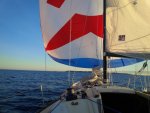wotayottie
New member
Last week we caught up and became overlapped with another boat, both of us with mains boomed out to starboard and spinnakers flying. We were on his port side. He started veering towards us demanding that we kept clear. Both of us were well away from the mark or any obstruction.
Now as I understand it we were the windward boat as in " However, when sailing by the lee or directly downwind, her leeward side is the side on which her mainsail lies. The other side is her windward side. When two boats on the same tack overlap, the one on the leeward side of the other is the leeward boat. The other is the windward boat"
But when rule 17 says"If a boat clear astern becomes overlapped within two of her hull lengths to leeward of a boat on the same tack, she shall not sail above her proper course""clear astern" .
As I read it that means that we shouldnt sail above our proper course which we didnt but there was no obligation on him.
Correct?
Now as I understand it we were the windward boat as in " However, when sailing by the lee or directly downwind, her leeward side is the side on which her mainsail lies. The other side is her windward side. When two boats on the same tack overlap, the one on the leeward side of the other is the leeward boat. The other is the windward boat"
But when rule 17 says"If a boat clear astern becomes overlapped within two of her hull lengths to leeward of a boat on the same tack, she shall not sail above her proper course""clear astern" .
As I read it that means that we shouldnt sail above our proper course which we didnt but there was no obligation on him.
Correct?

